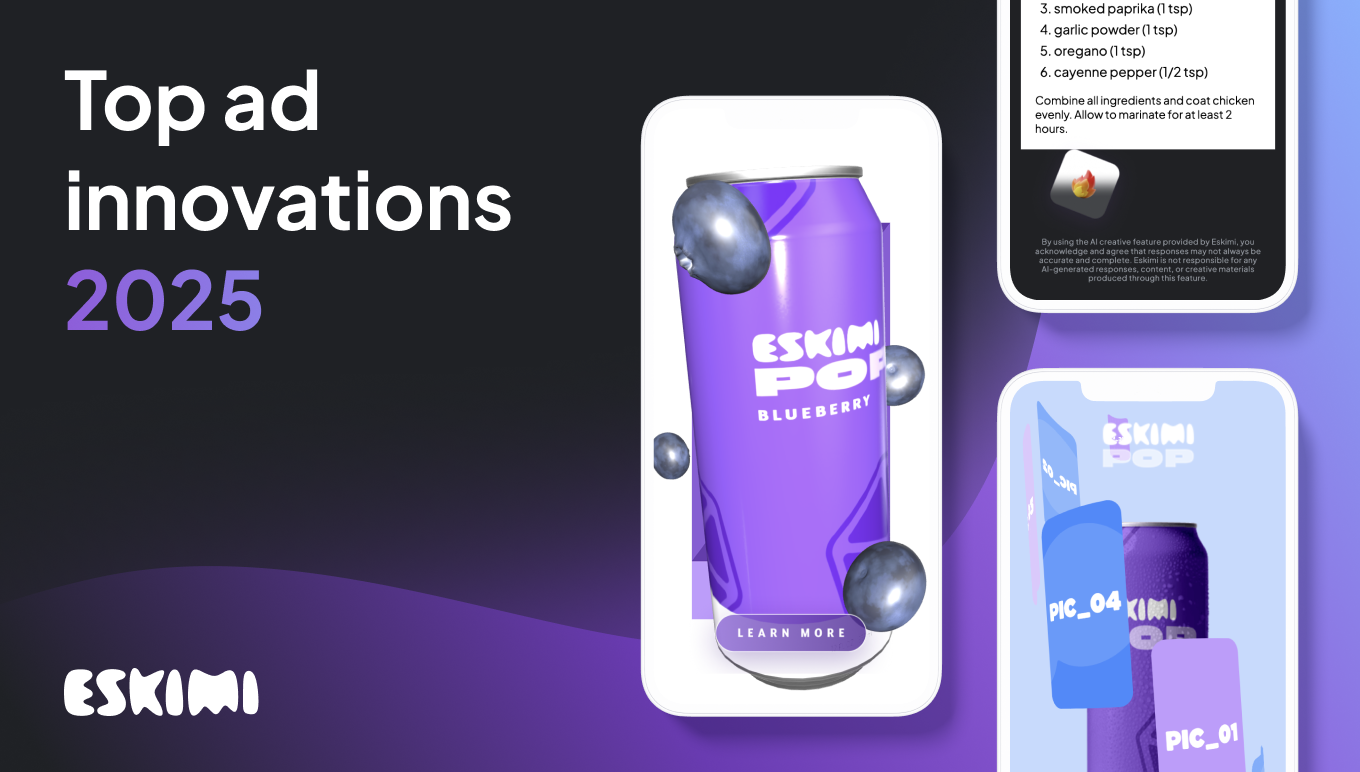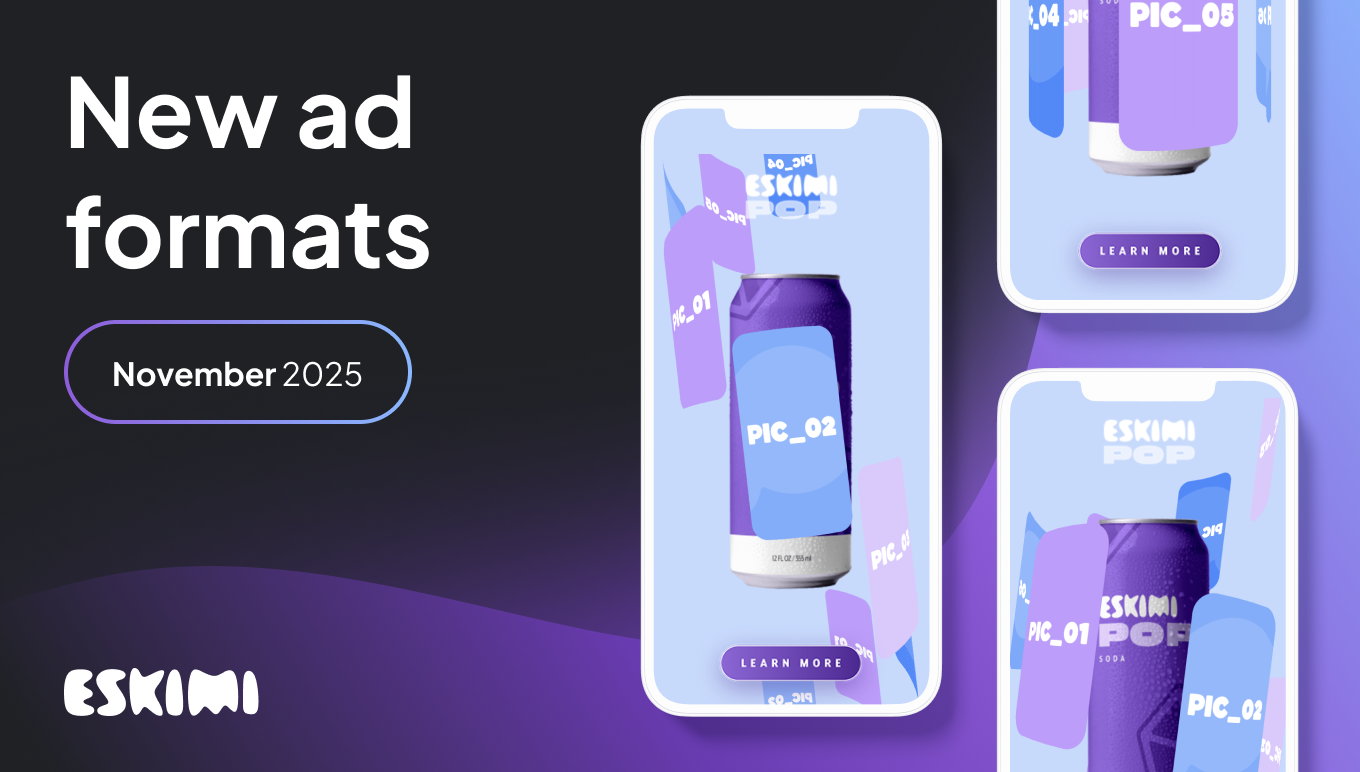Connected TV (CTV) Statistics And Trends For 2024 And Beyond

When was the last time you watched a movie or a series? Or played a video game?
OK, probably not THAT long ago.
But let’s exclude Netflix, HBO, and Amazon Prime. Don’t think about consoles like PlayStation and Xbox as well. No streaming. Only traditional TV. So, when?
We bet that’ll take longer to answer. At least that’s what the rising popularity of connected TV (CTV) shows – and that’s no surprise considering all the handful of video streaming options it has to offer.
Especially during the COVID-19 pandemic, cord-cutting has become a way to go for many wishing to reduce spending on traditional (linear) TV and explore limitless streaming options. No wonder the growing CTV market has also attracted unprecedented advertisers’ attention.
So, what’s been happening in the CTV industry, and what are the forecasts for CTV and CTV advertising?
We’ve gathered a bunch of facts, stats, and trends to cover it all.
What is connected TV (CTV)?
Before we jump into facts and numbers, let's quickly run through the essentials.
In short, connected TV is a method that allows users to stream content on their television sets via the internet. It’s connected to the web either through a built-in (smart TV) or an external device like a set-top box, video game console, or a dongle connected to the HDMI port.
Some examples of CTV devices:
- Smart TVs – devices that have a built-in internet connection and media apps – Netflix, Tubi, Prime Video, HBOMax, Paramount+.
- Gaming consoles – consoles like PlayStation, Xbox, and Nintendo Switch can be connected to the TV and have streaming functionalities in their app stores, including Youtube, Twitch, Netflix.
- Internet-connected devices – also known as Over-The-Top (OTT) devices, that can be plugged into TVs (even if they’re not Smart TVs) and connect them to the internet to use apps and stream videos, like Chromecast, Roku, and Amazon Fire Stick.

CTV market overview: what’s in there?
Firstly, let’s go through a quick CTV market overview. Hours of connected TV viewing increased 21% in May 2023 compared to May 2022, according to Comscore’s latest State of Streaming report.
CTV usage in an all-time-high
The study by Leichtman Research Group (LRG) reveals the latest number of US CTV households, showing consistent growth from 2014.
87% of US TV households have at least one Internet-connected TV device, including connected Smart TVs, stand-alone streaming devices (like Roku, Amazon Fire TV sticks or boxes, Chromecast, or Apple TV), connected video game systems, and/or connected Blu-ray players.

This compares to 80% with at least one connected TV device in 2020, 69% in 2017, and 38% in 2012.
46% of adults in the US households watch video on a TV via a connected device daily – compared to 40% in 2020, 25% in 2017, and 4% in 2012.
Millennials and Gen Z quickest to adopt CTV
While the number of CTV users is constantly growing among younger generations, this type of TV technology is not that popular among Gen X and baby boomers.
In 2022, the number of monthly connected TV users among Millennials reached 60.5 million, and it’s estimated this number will hit 62.6 million by 2025 (+2.1 million growth).

The number of monthly CTV users in Gen Z is forecasted to increase from 49.6 million individuals in the US in 2022 to 56.1 million by 2025 (+6.5 million growth).
Recent consumer research by Leichtman Research Group, Inc. (LRG) also shows younger individuals are most likely to use connected TV devices. Among the ages of 18-34, 62% of people watch video on a TV via a connected device daily – compared to 54% of ages 35-54 and 24% of ages 55+.
Roku is taking the lead
In Q3 2020 (in the heat of COVID-19), the top five CTV devices based on the share of streaming hours were:
- Roku – 48%.
- Amazon Fire TV – 28%.
- Apple TV – 8.5%.
- Google Chromecast – 6.8%.
- Android TV – 5.5%.
Latest CTV trends & statistics
In this section, we’ll cover the hottest numbers related to connected TV and CTV advertising that naturally goes hand in hand for marketers: growth, performance, ad spend, growth drivers, challenges, and more.
1. CTV is growing, and so is CTV advertising
CTV advertising is a developing concept that combines the simplicity of digital advertising with the immense reach of traditional TV.
- In 2023, 88% of U.S. households owned at least one internet-connected TV device
- The number of CTV users was more than 110 million among Gen Z and Millennials.
- Around 73% of connected TV viewers prefer to watch free ad-supported content vs paying for ad-free CTV content.
2. CTV ad spend to boom
The Trade Desk study revealed that 87% of marketers find CTV advertising as effective (or even more!) as traditional TV advertising. So, what’s behind the CTV ads that make them so efficient?
- In 2022, connected TV (CTV) advertising spending in the United States was valued at 20.69 billion U.S. dollars. At the current pace, CTV ad spending is expected to grow to 40.9 billion U.S. dollars by 2027.
- 95% of marketers reported CTV achieved desired key performance indicators, according to Trade Desk study.

Despite these numbers, the IAB claims that the advertising sector hasn’t yet caught up to where viewers are paying the most attention.
3. Europe tends to be slower
Europe as a region for CTV advertising lags behind the US, but in the last 12 months, markets have broken through the glass ceiling of innovation.
The CTV advertising market in Europe is still relatively small. While the United States has seen significant growth in CTV consumption and rapid growth in ad-funded CTV, the pace of change is slower in Europe.
The key motivator in the US has been the high cost of traditional TV services.
4. CTV outperforms mobile
In the first half of 2022, a study by FreeWheel revealed that Connected TV (CTV) dominated video advertising views, accounting for 71% of the total. This marked a significant increase of over 10% compared to its share in the same period in 2021. In contrast, mobile platforms, which had held 11% of ad views in the first half of the previous year, saw a different trend.
Moreover, 46% of adults say that they find television advertising to be the most trustworthy ad channel, as compared to social media’s 19%.
5. CTV advertisers see more benefits
Innovid and Digiday compiled a report that reveals even more advantages advertisers see in CTV advertising. Even though CTV is relatively new, marketers surveyed name the plentiful possibilities it brings along:
- 64% of marketers expect stronger connections between digital and TV.
- 63% of respondents say CTV ads can allow more precise audience targeting.
- 51% of the respondents say CTV can improve ad relevance.
- Others expect CTV advertising will give them comprehensive measurement and data insights (44%), allow engaging creative formats (41%), and save time and costs (29%).

6. CTV works well with an omnichannel strategy
The ability to effortlessly integrate with an existing omnichannel strategy is one of the major advantages of CTV advertising.
According to Digiday and Innovid, most marketers are employing CTV ads together with traditional media, such as social media (86%), display advertising (78%), mobile video (77%) and desktop video (67%), or linear TV (54%).
7. Brand awareness is rising thanks to CTV
The Innovid and Digiday report also looked into the top KPIs that CTV marketers value most: conversions/revenue, reach, and brand awareness.
When asked how investing in CTV advertising influenced business, advertisers surveyed pointed out these aspects:
- 59% of advertisers said investing in CTV advertising raised their brand awareness.
- 49% of advertisers said CTV advertising increased brand engagement, including website and store visits.
- 25% of surveyed people claimed CTV ads brought them higher conversion rates.
- Finally, 18% of respondents noticed an increase in returning customers.

8. Fragmentation as a challenge
The report also demonstrated that fragmentation is a significant issue that marketers must successfully address to gauge the effectiveness of CTV advertising.
CTV will likely become more fragmented as additional choices enter the market, from new original equipment manufacturers (OEMs) to ad-based video on demand.
Other significant challenges marketers named when integrating CTV advertising include:
- Choosing the appropriate audience segments to target (53% of the surveyed people).
- Unreliable measurement (57% of the surveyed people).
9. Targeting, simplicity, and accessibility – key growth drivers
So, why is CTV good?
It acts as a union of linear TV and digital marketing, connecting the best of both worlds into a powerful format. As a result, it’s a TV that functions like a digital ad channel – the powerful storytelling medium of TV mixed with precise audience targeting, more accurate reporting, and insightful analytics.
Veteran Wall Street media analyst Dan Salmon of BMO Capital released a report where he called out four key growth factors for CTV advertising as opposed to traditional TV:
- Advanced targeting, which allows ad delivery to groups of individuals or households rather than just large demographic categories – especially appealing to advertisers focused on bottom-of-the-funnel performance.
- Programmatic tools and automation, which make ad execution quick and hassle-free.
- Self-service tools and APIs, which greatly improve the accessibility for large pools of small and medium-sized advertisers.
- Ability to find and reach younger audiences, which brand advertisers can’t so easily find on traditional TV.

10. Relevance is the key, but don’t forget privacy
Consumers are more likely to watch an ad all the way through if it’s relevant to the video content they’re interacting with. Contextual ad relevance in streaming content aids in keeping their attention.
- More than half (55%) of surveyed consumers are likely to view an ad through the end if it’s contextually appropriate and related to the streaming content they’re engaging with.
- Ad personalization in CTV environments is a key component aspect of effective advertising, with 37% of EU6 (UK, Italy, France, Germany, Spain, Netherlands) participants preferring ads relevant to their individual interests or hobbies, according to the study done by FreeWheel and Happydemics.
- Additionally, the study respondents who watched CTV were open to ads tailored to their values and lifestyles (33% and 23%, respectively).

That being said, the survey showed that connected TV viewers are quite concerned about their personal data, with 62% of respondents saying they wouldn’t be ready to give it in return for individualized advertising.
Similarly, the majority of buyers (84%) who’re increasing spending on CTV cited consumer privacy as the reason for their increases, and this trend will continue to grow in 2022.
So, it’s crucial for all participants in this data-driven advertising ecosystem to prioritize consumers and preserve their privacy in all they do.
11. Positive CTV ad experience in Europe
Research from ShowHeroes Group used state-of-the-art Tobii eye tracking glasses, along with eSense electrodermal response sensors, to measure the attentiveness of TV viewers, including on CTV (smart TVs and streaming devices) in a home setting.
These biometric results were then combined with a quantitative survey of 2,100 respondents in seven key European markets, in findings that will have widespread implications for the digital ad industry.
Sarah Lewis, the global director, CTV at ShowHeroes Group, said: “This wide-ranging experiment is the first time we’ve seen exactly how user experience manifests itself: both as an emotional and attention-based response in front of the CTV screen, and within a wider mass sample of European viewers. Because of the high attention that users have in relation to CTV content, paired with high engagement levels, our research shows that connected TV really hits the sweet spot when it comes to delivering a positive ad experience.”
- 62% of users said they use CTV because of its flexibility, with “range of content” and “ease of use” ranking as other top reasons for switching from linear.
- Users saw CTV ads as shorter, more relevant, and better quality than linear TV ads.
- 43% of users looked for a product after viewing a CTV ad. One-third have visited an advertiser’s website, and 1 in 5 have actually purchased a product after seeing a CTV ad.
- 67% of users said they would prefer watching CTV ads relevant to the content they’re watching.
12. It’s time for brands to follow consumer attention
Eric John, VP of the IAB Media Center, claimed in the report that “the time is now for brands and buyers to follow consumer attention” and bet it all on CTV. The study listed these motivations behind:
- Broad data. CTV gives access to data that’s incompatible with traditional TV – first-party brand data, location data, and shopping data.
- Greater returns. 57% of media buyers said CTV was more efficient than traditional TV in leading to website and sales actions, while 46% stated it was “more effective at delivering brand perception.”
- More transparency. Respondents stressed the bigger transparency of CTV compared to other social or digital videos where ads are running.
- Independence from third-party cookies. Media buyers marked no dependence on third-party cookies, which are on their way out anyway.

13. Marketers are seeking out CTV experts
The same report by Innovid and Digiday revealed that new audience engagement techniques and audience growth will be part of CTV's future as marketers increasingly employ it as a constant component of their omnichannel marketing strategy.
Yet, advertisers are also aware of the difficulties they would face in switching to CTV, like inventory fragmentation and inconsistent measurement.
As they try to improve CTV, marketing teams must invest in technology that will allow them to create an omnichannel strategy and efficiently distribute, customize, and measure ads across all screens and devices.
Advertisers that have access to these tools will succeed as TV movies go more and more online, away from the cord.
So, what steps have the surveyed marketers taken so far to measure CTV ad performance better?
- 68% of surveyed advertisers partnered with ad-tech companies (DSP, SSP, ad servers) to better measure CTV ad performance.
- Significantly smaller portions of advertisers chose other ways to drive their CTV performance: hiring in-house experts (27%), working with advertising agencies (18%), and engaging a consulting firm (17%).

How much does a CTV campaign cost today?
Above, we’ve shared a bunch of facts and numbers proving that investing in CTV ads is worth it. Just one last question – how much does it actually cost?
The good news is there’s no minimum. While traditional TV advertising demands large budgets at the front – on average 104,700 US dollars for a 30-second commercial on a national network – CTV gives brands and marketers more flexibility, easiness, and accessibility.
Of course, spending 20 dollars on CTV advertising most likely wouldn’t be the wisest business decision. Advertisers need to evaluate what target audience, when, and where they’re trying to reach.
A very tight target within a clear, specific niche can be reached for a couple of thousand dollars.
Wrap up
All the numbers above indicate that people’s habits are changing and “watching TV” is moving toward a more digital approach. As more viewers turn into streaming or CTV, this change becomes significant for marketers who now have to adapt and find the right balance in navigating between two worlds if they want to match consumers’ media consumption trends.
This is clearly an exciting opportunity with a lot of potential and also many challenges to overcome. However, with the right tools and attitude, advertisers will be able to discover what CTV really has to offer for their businesses' growth.
Level Up Your Advertising with Eskimi
- Reach 96% of Open Web
- 2,500+ Targeting Options
- 100% Managed or Self-Service
- In-House Creative Studio Team
- Display, Video, In-Game & CTV
- #1 Rated DSP on G2





